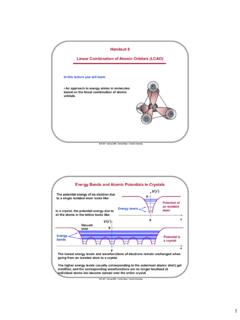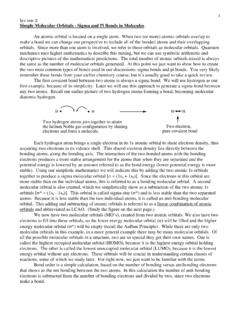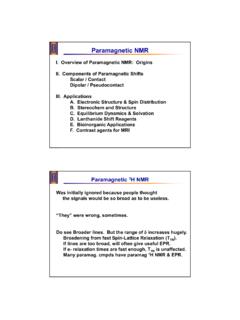Transcription of VASP: Basics (DFT, PW, PAW, … ) - NERSC
1 VASP: Basics (DFT, PW, PAW, .. )University of Vienna,Faculty of Physics and Center for Computational Materials Science,Vienna, AustriaOutline Density functional theory Translational invariance and periodic boundary conditions Plane wave basis set The Projector-Augmented-Wave method Electronic minimizationThe Many-Body Schr dinger equation H (r1,..,rN)=E (r1,..,rN)0@ 12Xi i+XiV(ri)+Xi6=j1|ri rj|1A (r1,..,rN)=E (r1,..,rN) (r1,..,rN)!{ 1(r), 2(r),.., N(r)}For instance, many-body WF storage demands are prohibitive:A solution: map onto one-electron theory:5 electrons on a 10 10 10 grid ~ 10 PetaBytes!
2 (r1,..,rN)(#grid points)NHohenberg-Kohn-Sham DFTE[ ]=Ts[{ i[ ]}]+EH[ ]+Exc[ ]+EZ[ ]+U[Z] (r1,..,rN)=NYi i(ri) (r)=NXi| i(r)|2 12 +VZ(r)+VH[ ](r)+Vxc[ ](r) i(r)= i i(r) (r1,..,rN)!{ 1(r), 2(r),.., N(r)}Map onto one-electron theory:Total energy is a functional of the density:The density is computed using the one-electron orbitals:The one-electron orbitals are the solutions of the Kohn-Sham equation:BUT:Exc[ ]=???Vxc[ ](r)=???Exchange-CorrelationExc[ ]=???Vxc[ ](r)=??? Exchange-Correlation functionalsare modeled on the uniform-electron-gas (UEG): The correlation energy (and potential) has been calculated by means of Monte-Carlo methods for a wide range of densities, and has been parametrizedto yield a density functional.
3 LDA: we simply pretend that an inhomogeneous electronic density locally behaves like a homogeneous electron gas. Many, many, many different functionalsavailable:LDA, GGA, meta-GGA, van-der-Waals functionals, etcetcAn N-electron system: N = O(1023)N (#grid points)(#grid points)N (r1,..,rN)!{ 1(r), 2(r),.., N(r)}Hohenberg-Kohn-Sham DFT takes us a long way:Nice for atoms and molecules, but in a realistic piece of solid state material N= O(1023)!Translational invariance:Periodic Boundary Conditions nk(r+R)= nk(r)eikR nk(r)=unk(r)eikrunk(r+R)=unk(r)Translati onal invariance implies:andAll states are labeled by Bloch vectorkand the band indexn: The Bloch vector kis usually constrained to lie within the first Brillouinzoneof the reciprocal space lattice.
4 The band index n is of the order if the number of electrons per unit space & the first Brillouinzoneb2b1b3zyxCb2b1b3zyxB4pi/La2 a1a3yLzxAb1=2 a2 a3b2=2 a3 a1b3=2 a1 a2 =a1 a2 a3ai bj=2 ijSampling the 1stBZ (r)=1 BZXnZBZfnk| nk(r)|2dk (r)=Xnkwkfnk| nk(r)|2dk,The evaluation of many key quantities involves an integral over the instance the charge density:We exploit the fact that the orbitals at Bloch vectors kthat are close together arealmost identical and approximate the integral over the 1stBZ by a weighted sumover a discrete set of k-points:Fazit: the intractable task of determining with N=1023, has beenreduced to calculating at a discrete set of k-points in the 1stBZ, for anumber of bands that is of the order if the number of electrons in the unit cell.
5 (r1,..,rN) nk(r)brbrBZIBZk1k1k3k2044 4 k1=(18,18))!1=144 k2=(38,38))!2=148 k3=(38,18))!3=121 BZZBZF(k)dk)14F(k1)+14F(k2)+12F(k3)Idea: equally spaced mesh in the 1stBrillouinzoneExample: a quadratic 2D lattice q1=q2=4, , 16 points in total Only 3 symmetry inequivalentpoints:Algorithm: Calculate equally spaced mesh. Shift the mesh if desired. Apply all symmetry operations of the Bravaislattice to all k-points. Extract the irreducible k-points (IBZ). Calculate the proper meshes: Two different choices for the center of the mesh.
6 Centered on Centered around (can break the symmetry!) rrshifted to beforeaftersymmetrization In certain cell geometries ( cells) even meshes break the symmetry. Symmetrizationresults in non-uniform distributions of k-points. -point centered meshes preserve the [ ,{R,Z}]=Ts[{ nk[ ]}]+EH[ ,{R,Z}]+Exc[ ]+U({R,Z})Ts[{ nk[ ]}]=Xnkwkfnkh nk| 12 | nkiEH[ ,{R,Z}]=12ZZ eZ(r) eZ(r0)|r r0|dr0dr eZ(r)= (r)+XiZi (r Ri) (r)=Xnkwkfnk| nk(r)|2dk 12 +VH[ eZ](r)+Vxc[ ](r) nk(r)= nk nk(r)VH[ eZ](r)=Z eZ(r0)|r r0|dr0 The total energyThe kinetic energyThe HartreeenergywhereThe Kohn-Sham equationsThe HartreepotentialA plane wave basis setunk(r+R)=unk(r) nk(r)=unk(r)eikrunk(r)=1 1/2 XGCG nkeiGr nk(r)=1 1/2 XGCG nkei(G+k)r (r)=XG GeiGr12|G+k|2<Ecuto V(r)
7 =XGVGeiGrAll cell-periodic functions are expanded in plane waves (Fourier analysis):The basis set includes all plane waves for whichCrnk=XGCG nkeiGrFFT !CGnk=1 NFFTXrCrnke iGrTransformation by means of FFT between real space and reciprocal space:Why use plane waves? Historical reason: Many elements exhibit a band-structure that canbe interpreted in a free electron picture (metallic s and p elements).Pseudopotentialtheory was initially developed to cope with theseelements (pseudopotentialperturbation theory). Practical reason: The total energy expressions and the Hamiltonianare easy to implement.
8 Computational reason: The action of the Hamiltonian on the orbitalscan be efficiently evaluated using FFTs. 1 1 / 1 2b1b2real spacereciprocal spaceFFT01 2301 1 x = n / N1 1 g = n 2N 1 1 2 3 40123455N/2 N/2+1cutGCrnk=XGCG nkeiGrFFT !CGnk=1 NFFTXrCrnke iGr 1 1 / 1 2b1b2real spacereciprocal spaceFFT01 2301 1 x = n / N1 1 g = n 2N 1 1 2 3 40123455N/2 N/2+1cutGCrnk=XGCG nkeiGrFFT !CGnk=1 NFFTXrCrnke iGrCrnk=XGCG nkeiGrFFT !CGnk=1 NFFTXrCrnke iGr 1 1 / 1 2b1b2real spacereciprocal spaceFFT01 2301 1 x = n / N1 1 g = n 2N 1 1 2 3 40123455N/2 N/2+1cutGCrnk=XGCG nkeiGrFFT !
9 CGnk=1 NFFTXrCrnke iGrThe charge density r G r r G2 GcutGcutFFTFFTThe action of the HamiltonianH| nki 12 +V(r) nk(r)hr|G+ki=1 1/2ei(G+k)r !hG+k| nki=CGnkNNPLWhG+k| 12 | nki=12|G+k|2 CGnkhG+k|V| nki=1 NFFTXrVrCrnke iGrNFFTlogNFFTThe actionUsing the convention Kinetic energy: Local potential: Exchange-correlation: easily obtained in real space FFT to reciprocal space Hartreepotential: solve Poisson eq. in reciprocal space Add all contributions FFT to real spaceThe actionV=VH[ ]+Vxc[ ]+VextVxc,r=Vxc[ r]VH,G=4 |G|2 GVG=VH,G+Vxc,G+Vext,G{VG} !
10 {Vr}{Vxc,r} !{Vxc,G}The action of the local potential4 e 2G 2 VGVr rRGR (residual vector)r G G2 Gcut3 GcutGcutFFTFFTaddThe Projector-Augmented-Wave methodThe number of plane waves needed to describe tightly bound (spatially strongly localized) states, and rapid oscillations (nodal features) of the orbitals near the nucleusexceeds any practical limit, except maybe for Li and common solution: Introduce the frozen core approximation:Core electrons are pre-calculated in an atomic environment and kept frozenin the course of the remaining calculations.













